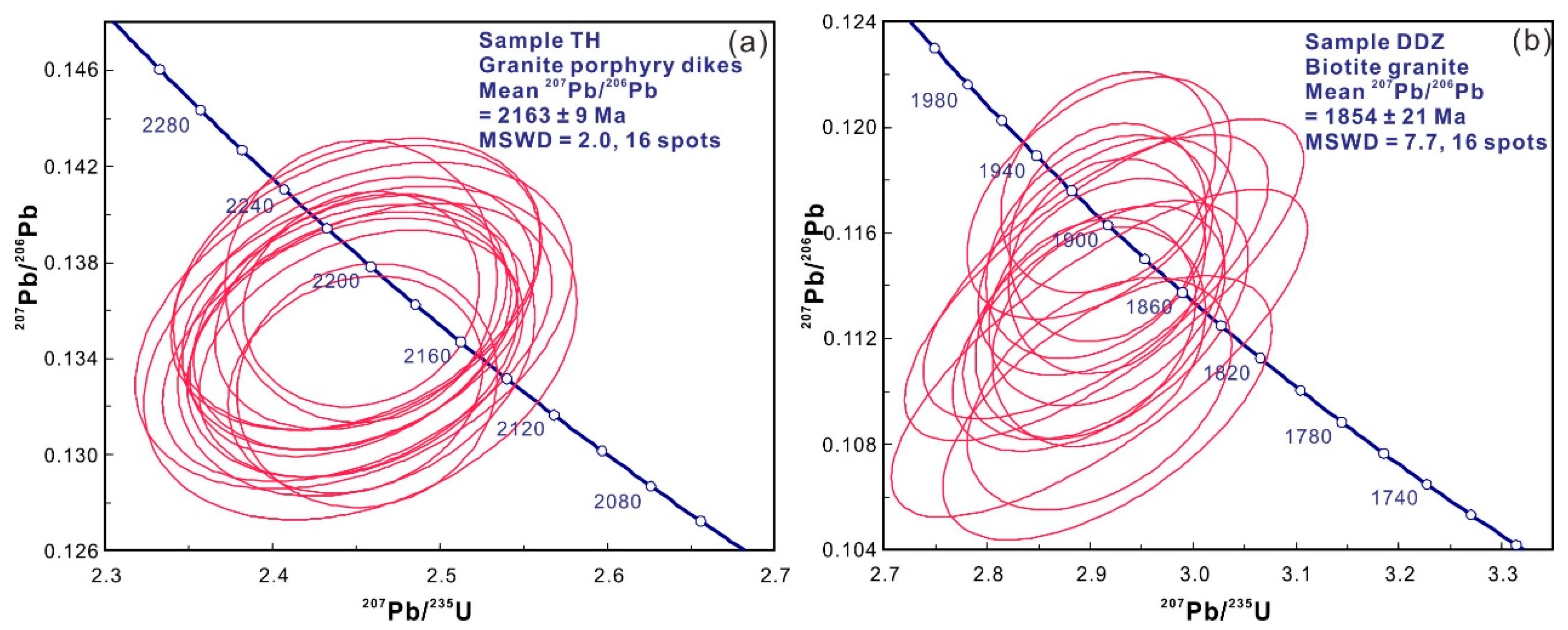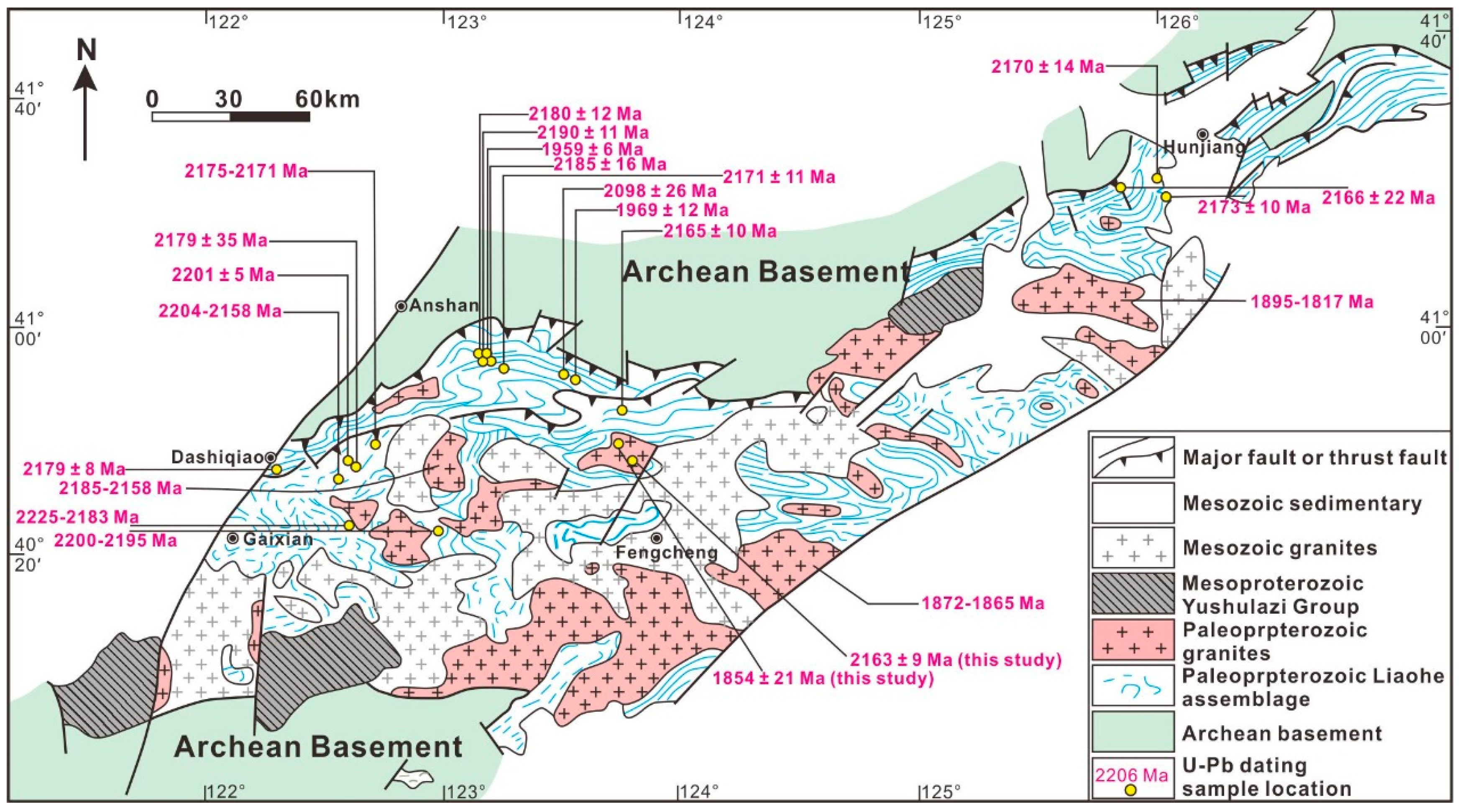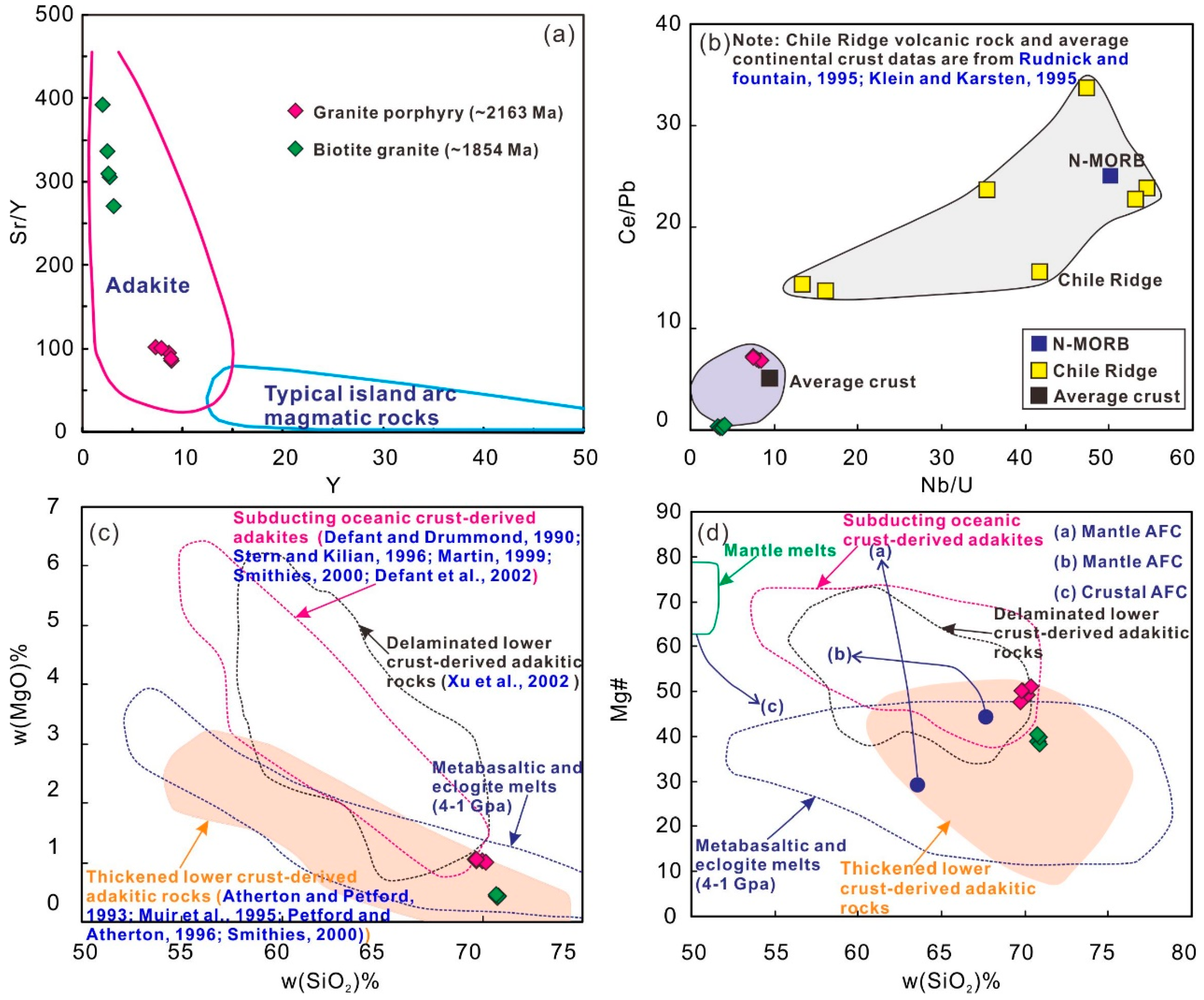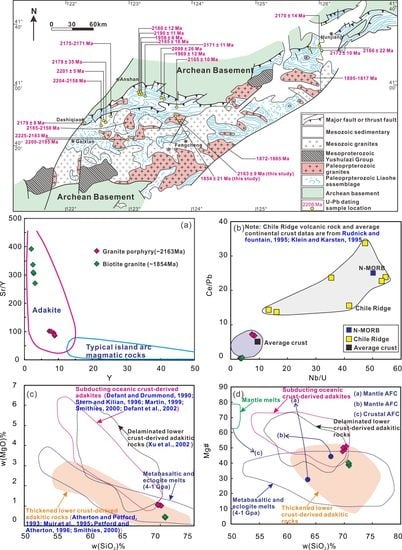Paleoproterozoic Adakitic Rocks in Qingchengzi District, Northeastern Jiao-Liao-Ji Belt: Implications for Petrogenesis and Tectonism
Abstract
:1. Introduction
2. Geological Setting
2.1. Tectonic Framework
2.2. Local Geology and Sample Descriptions
3. Analytical Techniques
3.1. Zircon U-Pb Dating
3.2. Whole-Rock Major and Trace Element Analysis
3.3. Zircon Hf Isotopic Analysis
4. Results
4.1. Zircon U-Pb Ages
4.2. Whole-Rock Major and Trace Element Geochemistry
4.2.1. Granite Porphyry (Sample TH)
4.2.2. Biotite Granite (Sample DDZ)
4.3. Zircon Hf Isotopic Compositions
5. Discussion
5.1. Paleoproterozoic Magmatic Events of the Northeastern Jiao-Liao-Ji Belt
5.2. Petrogenesis Models of Magmatism in the Qingchengzi District
5.3. Implications for Tectonic Setting
6. Conclusions
- Our LA–ICP–MS zircon U-Pb dating determined that the Paleoproterozoic magmatism in the Qingchengzi district occurred during two periods: ~2163 Ma (granite porphyry) and ~1854 Ma (biotite granite).
- The Paleoproterozoic granitoids in Qingchengzi district have the affinity of adakitic rocks, which originated by partial melting of the thickened lower crust material in the Meso-Neoarchean.
- These granitoids were formed in the tectonic setting of an active continental margin that may be related to the subduction of oceanic crust between the Namgrim and Longgang blocks.
Supplementary Materials
Author Contributions
Funding
Acknowledgments
Conflicts of Interest
References
- Wan, Y.S.; Li, R.W.; Wilde, S.A.; Liu, D.Y.; Chen, Z.Y.; Yan, L.; Song, T.R.; Yin, X.Y. UHP metamorphism and exhumation of the Dabie Orogen, China: Evidence from SHRIMP dating of zircon and monazite from a UHP granitic gneiss cobble from the Hefei Basin. Geochim. Cosmochim. Acta 2005, 69, 4333–4348. [Google Scholar] [CrossRef]
- Wan, Y.S.; Dong, C.Y.; Jie, W.Q.; Liu, S.J.; Ma, M.Z.; Xie, S.Y.; Ren, P.; Sun, H.Y.; Liu, D.Y. Some Progress in the Study of Archean Basement of the North China Craton. Acta. Geoscientica. Sin. 2015, 36, 685–700. [Google Scholar]
- Zhao, G.C.; Sun, M.; Wilde, S.A.; Li, S.Z. Late Archean to Paleoproterozoic evolution of the North China Craton: Key issues revisited. Precambr. Res. 2005, 136, 177–202. [Google Scholar] [CrossRef]
- Zhao, G.C.; Li, S.Z.; Sun, M.; Wilde, S.A. Assembly, Accretion and Breakup of the Paleo-Mesoproterozoic Columbia Supercontinent: Records in the North China Craton. Int. Geol. Rev. 2011, 53, 1331–1356. [Google Scholar] [CrossRef]
- Zhao, G.C.; Cawood, P.A.; Li, S.Z.; Wilde, S.A.; Sun, M.; Zhang, J.; He, Y.H.; Yin, C.Q. Amalgamation of the North China Craton: Key issues and discussion. Precambr. Res. 2012, 222, 55–76. [Google Scholar] [CrossRef] [Green Version]
- Zhai, M.G.; Santosh, M. The early Precambrian odyssey of the North China Craton: A synoptic overview. Gondwana Res. 2011, 20, 6–25. [Google Scholar] [CrossRef]
- Li, S.Z.; Liu, Y.J.; Yang, Z.S.; Ma, R. Continental dynamics and regional metamorphism of the Liaohe Group. Geol. Rev. 2001, 47, 9–18. [Google Scholar]
- Lu, X.P.; Wu, F.Y.; Lin, J.Q.; Sun, D.Y.; Zhang, Y.B.; Guo, C.L. Geochronological successions of the early Precambrian granitic magmatism in southern Liaodong Peninsula and its constraints on tectonic evolution of the North China Craton. Chin. J. Geol. 2004, 39, 123–138. [Google Scholar]
- Wan, Y.S.; Song, B.; Liu, D.Y.; Wilde, S.A.; Wu, J.S.; Yin, X.Y.; Zhou, H.Y. SHRIMP U-Pb zircon geochronology of Palaeoproterozoic metasedimentary rocks in the North China Craton: Evidence for a major Late Palaeoproterozoic tectonothermal event. Precambr. Res. 2006, 149, 249–271. [Google Scholar] [CrossRef]
- Liu, F.L.; Liu, P.H.; Wang, F.; Liu, C.H.; Cai, J. Progresses and overviews of voluminous meta-sedimentary series within the Paleoproterozoic Jiao-Liao-Ji orogenic/mobile belt, North China Craton. Acta Petrol. Sin. 2015, 31, 2816–2846. [Google Scholar]
- Zhao, G.C.; Wilde, S.A.; Cawood, P.A.; Lu, L.Z. Thermal evolution of the Archaean basement rocks from the eastern part of the North China Craton and its bearing on tectonic setting. Int. Geol. Rev. 1998, 40, 706–721. [Google Scholar] [CrossRef]
- Zhao, G.C.; Wilde, S.A.; Cawood, P.A.; Sun, M. Archean blocks and their boundaries in the North China Craton: Lithological, geochemical, structural and P–T, path constraints and tectonic evolution. Precambr. Res. 2001, 107, 45–73. [Google Scholar] [CrossRef]
- Wilde, S.A.; Zhao, G.C.; Sun, M. Development of the North China Craton during the late Archaean and its final amalgamation at 1.8 Ga: Some speculations on its position within a global Palaeoproterozoic supercontinent. Gondwana Res. 2002, 5, 85–94. [Google Scholar] [CrossRef]
- Wilde, S.A.; Cawood, P.A.; Wang, K.; Nemchin, A.A. Granitoid evolution in the Late Archean Wutai Complex, North China Craton. J. Asian Earth Sci. 2005, 24, 597–613. [Google Scholar] [CrossRef]
- Kröner, A.; Wilde, S.A.; Zhao, G.C.; O’Brien, P.J.; Sun, M.; Liu, D.Y.; Wan, Y.S.; Liu, S.W.; Guo, J.H. Zircon geochronology and metamorphic evolution of mafic dykes in the Hengshan Complex of northern China: Evidence for late Palaeoproterozoic extension and subsequent high-pressure metamorphism in the North China Craton. Precambr. Res. 2006, 146, 45–67. [Google Scholar] [CrossRef]
- Yin, C.Q.; Zhao, G.C.; Sun, M.; Xia, X.P.; Wei, C.J.; Zhou, X.W.; Leung, W.H. LA-ICP-MS U-Pb zircon ages of the Qianlishan Complex: Constrains on the evolution of the Khondalite Belt in the Western Block of the North China Craton. Precambr. Res. 2009, 174, 78–94. [Google Scholar] [CrossRef]
- Yin, C.Q.; Zhao, G.C.; Guo, J.H.; Sun, M.; Xia, X.P.; Zhou, X.W.; Liu, C.H. U-Pb and Hf isotopic study of zircons of the Helanshan Complex: Constrains on the evolution of the Khondalite Belt in the Western Block of the North China Craton. Lithos 2011, 122, 25–38. [Google Scholar] [CrossRef]
- Santosh, M. Assembling North China Craton within the Columbia supercontinent: The role of double-sided subduction. Precambr. Res. 2010, 178, 149–167. [Google Scholar] [CrossRef]
- Li, X.P.; Yang, Z.; Zhao, G.; Grapes, R.; Guo, J. Geochronology of khondalite-series rocks of the Jining Complex: Confirmation of depositional age and tectonometamorphic evolution of the North China craton. Int. Geol. Rev. 2010, 53, 1194–1211. [Google Scholar] [CrossRef]
- Santosh, M.; Liu, S.J.; Tsunogae, T.; Li, J.H. Paleoproterozoic ultrahigh-temperature granulites in the North China Craton: Implications for tectonic models on extreme crustal metamorphism. Precambr. Res. 2012, 222, 77–106. [Google Scholar] [CrossRef]
- Santosh, M.; Liu, D.Y.; Shi, Y.R.; Liu, S.J. Paleoproterozoic accretionary orogenesis in the North China Craton: A SHRIMP zircon study. Precambr. Res. 2013, 227, 29–54. [Google Scholar] [CrossRef]
- Zhang, Q.S. Geology and Metallogeny at Early Proterozoic in China; Jilin People’s Press: Changchun, China, 1984; pp. 1–536. [Google Scholar]
- Zhang, Q.S. Early Crust and Deposit of Eastern Liaoning Peninsula; Geological Publishing House: Beijing, China, 1988; pp. 1–574. [Google Scholar]
- Sun, M.; Armstrong, R.L.; Lambert, R.S.J.; Jiang, C.B.; Wu, J.H. Petrochemistry and Sr, Pb and Nd isotopic geochemistry of the paleoproterozoic kuandian complex, the eastern Liaoning province, China. Precambr. Res. 1993, 62, 171–190. [Google Scholar]
- Peng, Q.M.; Palmer, M.R. The Palaeoproterozoic boron deposits in eastern Liaoning, China: A metamorphosed evaporite. Precambr. Res. 1995, 72, 185–197. [Google Scholar] [CrossRef]
- Liu, J.L.; Liu, Y.J.; Chen, H.; Sha, D.M.; Wang, H.C. The inner zone of the Liaoji paleorift: Its early structural styles and structural evolution. J. Asian Earth Sci. 1997, 15, 19–31. [Google Scholar] [CrossRef]
- Li, S.Z.; Liu, Y.J. Palaeoproterozoic sedimentary assemblages in the Jiao-Liao Massif: Ages and stratigraphic sequence. Northwestern Geol. 1997, 18, 13–20. [Google Scholar]
- Bai, J.; Huang, X.G.; Dai, F.Y.; Wu, C.H. The Precambrian Evolution of China; Geological Publishing House: Beijing, China, 1993; pp. 199–203. [Google Scholar]
- Faure, M.; Lin, W.; Monie, P.; Bruguier, O. Paleoproterozoic arc magmatism and collision in Liaodong Peninsula (north-east China). Terra Nova 2004, 16, 75–80. [Google Scholar] [CrossRef] [Green Version]
- Ma, L.J.; Cui, Y.C.; Liu, J.L.; Zhang, J.B. Geochemical Characteristics and the Tectonic Setting of Amphibolites of the North Liaohe Group in Liaodong Area. J. Shanxi Univ. (Nat. Sci. Ed.) 2007, 30, 515–523. [Google Scholar]
- Li, Z.; Chen, B. Geochronology and geochemistry of the Paleoproterozoic meta-basalts from the Jiao-Liao-Ji Belt, North China Craton: Implications for petrogenesis and tectonic setting. Precambr. Res. 2014, 255, 653–667. [Google Scholar] [CrossRef]
- Yuan, L.L.; Zhang, X.H.; Xue, F.H.; Han, C.M.; Chen, H.L.; Zhai, M.G. Two episodes of Paleoproterozoic mafic intrusions from Liaoning province, North China Craton: Petrogenesis and tectonic implications. Precambr. Res. 2015, 264, 119–139. [Google Scholar] [CrossRef]
- Yang, M.C.; Chen, B.; Yan, C. Petrogenesis of Paleoproterozoic gneissic granites from Jiao-Liao-Ji Belt of North China Craton and their tectonic implications. J. Earth Sci. Environ. 2015, 37, 31–51. [Google Scholar]
- Bi, J.H.; Ge, W.C.; Xing, D.H.; Yang, H.; Dong, Y.; Tian, D.X.; Chen, H.J. Palaeoproterozoic meta-rhyolite and meta-dacite of the Liaohe Group, JiaoLiao-Ji Belt, North China Craton: Petrogenesis and implications for tectonic setting. Precambr. Res. 2018, 314, 306–324. [Google Scholar] [CrossRef]
- Dong, Y.; Bi, J.H.; Xing, D.H.; Ge, W.C.; Yang, H.; Hao, Y.J.; Ji, Z.; Jing, Y. Geochronology and geochemistry of Liaohe Group and Liaoji granitoid in the Jiao-Liao-Ji Belt, North China Craton: Implications for petrogenesis and tectonic evolution. Precambr. Res. 2019, 332, 105399. [Google Scholar] [CrossRef]
- Whalen, J.B.; Currie, K.L.; Chappell, B.W. A-type granites: Geochemical characteristics, discrimination and petrogenesis. Contrib. Miner. Petrol. 1987, 95, 407–419. [Google Scholar] [CrossRef]
- Eby, G.N. Chemical subdivision of the A-type granitoids: Petrogenetic and tectonic implications. Geology 1992, 20, 641–644. [Google Scholar] [CrossRef]
- Pearce, J.A. Sources and settings of granitic rocks. Episodes 1996, 4, 120–125. [Google Scholar] [CrossRef] [Green Version]
- Liu, D.Y.; Nutman, A.P.; Compston, W.; Wu, J.S.; Shen, Q.H. Remnants of ≥3800 Ma crust in the Chinese part of the SinoKorean Craton. Geology 1992, 20, 339–342. [Google Scholar] [CrossRef]
- Song, B.; Nutman, A.P.; Liu, D.Y.; Wu, J.S. 3800–2500 Ma crustal evolution in the Anshan area of Liaoning Province, northeastern China. Precambr. Res. 1996, 78, 79–94. [Google Scholar] [CrossRef]
- Lu, X.P.; Wu, F.Y.; Guo, J.H.; Wilde, S.A.; Yang, J.H.; Liu, X.M.; Zhang, X.O. Zircon U-Pb geochronological constraints on the Paleoproterozoic crustal evolution of the Eastern block in the North China Craton. Precambr. Res. 2006, 146, 138–164. [Google Scholar] [CrossRef]
- Zhao, G.C.; Cawood, P.A. Precambrian geology of China. Precambr. Res. 2012, 222, 13–54. [Google Scholar] [CrossRef]
- Li, J.; Cai, W.Y.; Wang, K.Y.; Kim, N.H.; Liu, H.L.; Lee, J.G.; Yoo, B.C. Initial decratonization of the eastern North China Craton: New constraints from geochronology, geochemistry, and Hf isotopic compositions of Mesozoic igneous rocks in the Qingchengzi district. Geol. J. 2020, 55, 3796–3820. [Google Scholar] [CrossRef]
- Li, J.; Cai, W.Y.; Li, B.; Wang, K.Y.; Liu, H.L.; Yassa, K.; Qian, Y.; Lee, J.G.; Yoo, B.C. Paleoproterozoic SEDEX-type stratiform mineralization overprinted by Mesozoic vein-type mineralization in the Qingchengzi Pb-Zn deposit, Northeastern China. J. Asian Earth Sci. 2019, 184, 104009. [Google Scholar] [CrossRef]
- Li, J.; Wang, K.Y.; Cai, W.Y.; Sun, F.Y.; Liu, H.L.; Fu, L.J.; Qian, Y.; Lai, C.K. Triassic gold-silver metallogenesis in Qingchengzi orefield, North China Craton: Perspective from fluid inclusions, REE and H-O-S-Pb isotope systematics. Ore Geol. Rev. 2020, 121, 103567. [Google Scholar] [CrossRef]
- Wiedenbeck, M.; Allé, P.; Corfu, F.; Griffin, W.L.; Meier, M.; Oberli, F.; Quadt, V.A.; Roddick, J.C.; Spiegel, W. Three natural zircon standards for U-Th-Pb, Lu-Hf, trace element and REE analyses. Geostand. Newsl. 1995, 19, 1–23. [Google Scholar] [CrossRef]
- Liu, Y.S.; Gao, S.; Hu, Z.C.; Gao, C.G.; Zong, K.Q.; Wang, D.B. Continental and oceanic crust recycling-induced melt-peridotite interactions in the Trans-North China Orogen: U-Pb dating, Hf isotopes and trace elements in zircons of mantle xenoliths. J. Petrol. 2010, 51, 537–571. [Google Scholar] [CrossRef]
- Ludwig, K.R. User’s manual for isoplot 3.0: A geochronological toolkit for Microsoft Excel. Berkeley Geochronol. Center Spec. Publ. 2003, 4, 1–70. [Google Scholar]
- Andersen, T. Correction of common lead in U-Pb analyses that do not report 204Pb. Chem. Geol. 2002, 192, 59–79. [Google Scholar] [CrossRef]
- Geng, J.Z.; Qiu, K.F.; Gou, Z.Y.; Yu, H.C. Tectonic regime switchover of Triassic Western Qinling Orogen: Constraints from LA-ICP-MS zircon U-Pb geochronology and Lu–Hf isotope of Dangchuan intrusive complex in Gansu, China. Chem. Erde. 2017, 77, 637–651. [Google Scholar] [CrossRef]
- Hoskin, P.W.O.; Black, L.P. Metamorphic zircon formation by solid-state recrystallization of protolith igneous zircon. J. Metamorphic Geol. 2000, 18, 423–439. [Google Scholar] [CrossRef]
- Le Maitre, R.W. Igneous Rocks. A Classification and Glossary of Terms; Cambridge University Press: Cambridge, UK, 2002; pp. 1–236. [Google Scholar]
- Irvine, T.H.; Baragar, W.R.A. A guide to the chemical classification of the common volcanic rocks. Can. J. Earth. Sci. 1971, 8, 523–548. [Google Scholar] [CrossRef]
- Peccerillo, A.; Taylor, D.R. Geochemistry of Eocene calc-alkaline volcanic rocks from the Kastamonu Area, Northern Turkey. Contrib. Miner. Petrol. 1976, 58, 63–81. [Google Scholar] [CrossRef]
- Maniar, P.D.; Piccoli, P.M. Tectonic discrimination of granitoids. Geol. Soc. Am. Bull. 1989, 101, 635–643. [Google Scholar] [CrossRef]
- Sun, S.S.; McDonough, W.F. Chemical and isotopic systematics of oceanic basalts: Implications for mantle composition and processes. In Magmatism in Ocean Basins; Saunders, A.D., Norry, M.J., Eds.; Geological Society Special Publications: London, UK, 1989; Volume 42, pp. 313–345. [Google Scholar]
- Griffin, W.L.; Wang, X.; Jackson, S.E.; Pearson, N.J.; O’Reilly, S.Y.; Xu, X.S.; Zhou, X.M. Zircon chemistry and magma mixing, SE China: In-situ analysis of Hf isotopes, Tonglu and Pingtan igneous complexes. Lithos 2002, 61, 237–269. [Google Scholar] [CrossRef]
- Song, Y.H.; Yang, F.C.; Yan, C.L.; Wei, M.H.; Shi, S.S. SHRIMP U-Pb ages and Hf isotopic compositions of Paleoproterozoic granites from eastern part of Liaoning Province and their tectonic significance. Acta Geol. Sin. 2016, 90, 2620–2636. [Google Scholar]
- Yang, J.H.; Wu, F.Y.; Shao, J.A.; Wilde, S.A.; Xie, L.W.; Liu, X.M. Constraints on the timing of uplift of the Yanshan Fold and Thrust Belt, North China. Earth Planet. Sci. Lett. 2006, 246, 336–352. [Google Scholar] [CrossRef]
- Li, S.Z.; Zhao, G.C.; Santosh, M.; Liu, X.; Dai, L.M. Palaeoproterozoic tectonothermal evolution and deep crustal processes in the Jiao–Liao–Ji Belt, North China Craton: A review. Geol. J. 2011, 46, 525–543. [Google Scholar] [CrossRef]
- Defant, M.J.; Drummond, M.S. Derivation of some modern arc magmas by melting of young subducted lithosphere. Nature 1990, 347, 662–665. [Google Scholar] [CrossRef]
- Stern, C.R.; Kilian, R. Role of the subducted slab, mantle wedge and continental crust in the generation of adakites from the Austral Volcanic Zone. Contrib. Miner. Petrol. 1996, 123, 263–281. [Google Scholar] [CrossRef]
- Martin, H. Adakitic magmas: Modern analogues of Archean granitoids. Lithos 1999, 46, 411–429. [Google Scholar] [CrossRef]
- Smithies, R.H. The Archean tonalite–trondhjemite–granodiorite (TTG) series is not an analogue of Cenozoic adakite. Earth Planet. Sci. Lett. 2000, 182, 115–125. [Google Scholar] [CrossRef]
- Defant, M.J.; Xu, J.F.; Kepezhinskas, P.; Wang, Q.; Zhang, Q.; Xiao, L. Adakites: Some variations on a theme. Acta Petrol. Sin. 2002, 18, 129–142. [Google Scholar]
- Xu, J.F.; Shinjo, R.; Defant, M.J.; Wang, Q.; Papp, R.P. Origin of Mesozoic adakitic intrusive rock in the Ningzhen area of east China: Partial melting of delaminated lower continental crust? Geology 2002, 30, 1111–1114. [Google Scholar] [CrossRef]
- Atherton, M.P.; Petford, N. Generation of sodium-rich magmas from newly underplated basaltic crust. Nature 1993, 362, 144–146. [Google Scholar] [CrossRef]
- Stevenson, R.K.; David, J.; Parent, M. Crust evolution of the western Minto Block, northern Superior Province, Canada. Precambr. Res. 2006, 145, 229–242. [Google Scholar] [CrossRef]
- Castillo, P.R.; Janney, P.E.; Solidum, R.U. Petrology and geochemistry of Camiguin Island, southern Philippines: Insights to the source of adakites and other lavas in a complex arc setting. Contrib. Miner. Petrol. 1999, 134, 33–51. [Google Scholar] [CrossRef]
- Macpherson, C.G.; Dreher, S.T.; Thirlwall, M.F. Adakites without slab melting: High pressure differentiation of island arc magma, Mindanao, the Philippines. Earth Planet. Sci. Lett. 2006, 243, 581–593. [Google Scholar] [CrossRef] [Green Version]
- Streck, M.J.; Leeman, W.P.; Chesley, J. High-magnesian andesite from Mount Shasta: A product of magma mixing and contamination, not a primitive mantle melt. Geology 2007, 35, 351–354. [Google Scholar] [CrossRef]
- Klein, E.M.; Karsten, J.L. Ocean–ridge basalts with convergent-margin geochemical affinities from the Chile ridge. Nature 1995, 374, 52–57. [Google Scholar] [CrossRef]
- Rudnick, R.L.; Fountain, D.M. Nature and compositions of the continental crust: A lower crustal perspective. Rev. Geophys. 1995, 33, 267–309. [Google Scholar] [CrossRef] [Green Version]
- Muir, R.J.; Weaver, S.D.; Bradshaw, J.D.; Eby, G.N.; Evans, J.A. Geochemistry of the Cretaceous Separation Point Batholith, New Zealand: Granitoid magmas formed by melting of mafic lithosphere. J. Geol. Soc. 1995, 152, 689–701. [Google Scholar] [CrossRef]
- Li, S.Z.; Hao, D.F.; Han, Z.Z.; Zhao, G.C.; Sun, M. Paleoproterozoic deep processes and tectono-thermal evolution in Jiao-Liao Massif. Acta Geol. Sin. 2003, 77, 328–340. [Google Scholar]
- Luo, Y.; Sun, M.; Zhao, G.C.; Li, S.Z.; Xu, P.; Ye, K.; Xia, X.P. LA-ICP-MS U-Pb zircon ages of the Liaohe Group in the Eastern Block of the North China Craton: Constraints on the evolution of the Jiao-Liao-Ji Belt. Precambr. Res. 2004, 134, 349–371. [Google Scholar] [CrossRef]
- Li, S.Z.; Zhao, G.C.; Sun, M.; Han, Z.H.; Luo, Y.; Hao, D.F.; Xia, X.P. Deformation history of the Paleoproterozoic Liaohe assemblage in the eastern block of the North China Craton. J. Asian Earth Sci. 2005, 24, 659–674. [Google Scholar] [CrossRef]
- Zhang, Q.S.; Yang, Z.S. Early Crust and Mineral. Deposits of Liaodong Peninsula; Geological Publishing House: Beijing, China, 1988; pp. 218–450. [Google Scholar]
- Jiang, S.Y.; Palmer, M.R.; Peng, Q.M.; Yang, J.H. Chemical and stable isotopic compositions of Proterozoic metamorphosed evaporites and associated tourmalines from the Houxianyu borate deposit, eastern Liaoning, China. Chem. Geol. 1997, 135, 189–211. [Google Scholar] [CrossRef]
- Peng, Q.M.; Palmer, M.R.; Lu, J.W. Geology and geochemistry of the Paleoproterozoic borate deposits in Liaoning-Jilin, northeastern China: Evidence of meta-evaporites. Hydrobiologia 1998, 381, 51–57. [Google Scholar] [CrossRef]
- Grant, M.L.; Wilde, S.A.; Wu, F.Y.; Yang, J.H. The application of zircon cathodoluminescence imaging, Th-U-Pb chemistry and U-Pb ages in interpreting discrete magmatic and high-grade metamorphic events in the North China Craton at the Archean/Proterozoic boundary. Chem. Geol. 2009, 261, 155–171. [Google Scholar] [CrossRef]
- Wang, W.; Liu, S.W.; Cawood, P.A.; Bai, X.; Guo, R.R.; Guo, B.R.; Wang, K. Late Neoarchean subduction-related crustal growth in the Northern Liaoning region of the North China Craton: Evidence from ~2.55 to 2.50 Ga granitoid gneisses. Precambr. Res. 2016, 281, 200–223. [Google Scholar] [CrossRef] [Green Version]
- Li, J.; Cai, W.Y.; Fu, L.J.; Zhang, X.B.; Wang, K.Y.; Ma, X.L.; Sun, Y.C. Genesis and tectonic setting of the Bulage Pb–Zn deposit, Inner Mongolia, China: Evidence from geology, fluid inclusions, EMPA, H-O isotope systematics, zircon U-Pb geochronology, and geochemistry. Geol. J. 2020, 55, 344–371. [Google Scholar] [CrossRef]
- Li, J.; Wang, K.Y.; Fu, L.J.; Zhang, M.; Liu, H.L.; Liu, Q.Z.; Tang, W.H.; Wang, C.H. Adakitic rocks and A-type felsic dykes in the Changlingzi area. NE China: Constraints on multistage tectonism in the southern Great Xing’an Range. Geol. J. 2020. [Google Scholar] [CrossRef]
- Cai, W.Y.; Wang, Z.G.; Li, J.; Fu, L.J.; Wang, K.Y.; Yassa, K.; Li, S.D. Zircon U-Pb and molybdenite Re-Os geochronology and geochemistry of Jinchang porphyry gold-copper deposit, NE China: Two-phase mineralization and the tectonic setting. Ore Geol. Rev. 2019, 107, 735–753. [Google Scholar] [CrossRef]
- Cai, W.Y.; Wang, K.Y.; Li, J.; Fu, L.J.; Lai, C.K.; Liu, H.L. Geology, geochronology and geochemistry of large Duobaoshan Cu-Mo-Au orefield in NE China: Magma genesis and regional tectonic implications. Geosci. Front. 2020. [Google Scholar] [CrossRef]










© 2020 by the authors. Licensee MDPI, Basel, Switzerland. This article is an open access article distributed under the terms and conditions of the Creative Commons Attribution (CC BY) license (http://creativecommons.org/licenses/by/4.0/).
Share and Cite
Li, J.; Liu, H.; Wang, K.; Cai, W. Paleoproterozoic Adakitic Rocks in Qingchengzi District, Northeastern Jiao-Liao-Ji Belt: Implications for Petrogenesis and Tectonism. Minerals 2020, 10, 684. https://doi.org/10.3390/min10080684
Li J, Liu H, Wang K, Cai W. Paleoproterozoic Adakitic Rocks in Qingchengzi District, Northeastern Jiao-Liao-Ji Belt: Implications for Petrogenesis and Tectonism. Minerals. 2020; 10(8):684. https://doi.org/10.3390/min10080684
Chicago/Turabian StyleLi, Jian, Hanlun Liu, Keyong Wang, and Wenyan Cai. 2020. "Paleoproterozoic Adakitic Rocks in Qingchengzi District, Northeastern Jiao-Liao-Ji Belt: Implications for Petrogenesis and Tectonism" Minerals 10, no. 8: 684. https://doi.org/10.3390/min10080684
APA StyleLi, J., Liu, H., Wang, K., & Cai, W. (2020). Paleoproterozoic Adakitic Rocks in Qingchengzi District, Northeastern Jiao-Liao-Ji Belt: Implications for Petrogenesis and Tectonism. Minerals, 10(8), 684. https://doi.org/10.3390/min10080684




